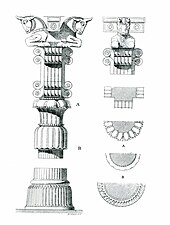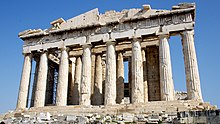Historic treatises
The earliest surviving written work on the subject of architecture is De architectura, by the Roman architect Vitruvius in the early 1st century CE. According to Vitruvius, a good building should satisfy the three principles of firmitatis utilitatis venustatis,which translates roughly as -
- Durability - it should stand up robustly and remain in good condition.
- Utility - it should be useful and function well for the people using it.
- Beauty - it should delight people and raise their spirits.
According to Vitruvius, the architect should strive to fulfill each of these three attributes as well as possible. Leone Battista Alberti, who elaborates on the ideas of Vitruvius in his treatise, De Re Aedificatoria, saw beauty primarily as a matter of proportion, although ornament also played a part. For Alberti, the rules of proportion were those that governed the idealised human figure, the Golden mean. The most important aspect of beauty was therefore an inherent part of an object, rather than something applied superficially; and was based on universal, recognisable truths. The notion of style in the arts was not developed until the 16th century, with the writing of Vasari. The treatises, by the 18th century, had been translated into Italian, French, Spanish and English.
In the early nineteenth century, Augustus Welby Northmore Pugin wrote Contrasts (1836) that, as the titled suggested, contrasted the modern, industrial world, which he disparaged, with an idealized image of neo-medieval world. Gothic architecture, Pugin believed, was the only “true Christian form of architecture.”
The 19th century English art critic, John Ruskin, in his Seven Lamps of Architecture, published 1849, was much narrower in his view of what constituted architecture. Architecture was the "art which so disposes and adorns the edifices raised by men ... that the sight of them" contributes "to his mental health, power, and pleasure".
For Ruskin, the aesthetic was of overriding significance. His work goes on to state that a building is not truly a work of architecture unless it is in some way "adorned". For Ruskin, a well-constructed, well-proportioned, functional building needed string courses or rustication, at the very least.
On the difference between the ideals of "architecture" and mere "construction", the renowned 20th C. architect Le Corbusier wrote: "You employ stone, wood, and concrete, and with these materials you build houses and palaces: that is construction. Ingenuity is at work. But suddenly you touch my heart, you do me good. I am happy and I say: This is beautiful. That is Architecture".


